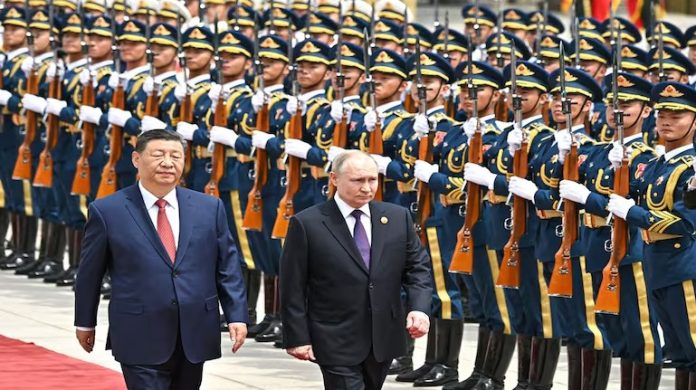Recently, Bangladesh complained about faulty Chinese spare parts for its Navy. As it emerges, all three military branches of Bangladesh are struggling with ‘sub-standard’ Chinese supplies. Many other countries (including Pakistan) are also unhappy about the poor quality of Chinese military supplies. Again, in March this year, SIPRI published a Report on ‘Trends in International Arms Transfers, 2023’. It emerged that Chinese arms exports declined by 5.3% during 2019-23 compared to 2014-18 period. All these indicate that China’s domestic military-industrial complex (MIC) is undergoing a bad phase and China’s fortunes, as an arms exporter, is insecure.
China is yet to respond to Bangladesh or any other country about the poor quality of weapons. In all probability, it will ignore the complaints. Similarly, it may plead that the universal trends in international arms transfers in last five years have not been encouraging. For example, the global volume of international arms transfers decreased marginally by 3.3% during 2019-23 compared to 2014-18 period.
Not Able to Fill The Gap Left By Russia
Such an excuse, however, is meaningless since China has been positioning itself as the global production-house for cheap weapons, soliciting African and Asian countries.
The ubiquitous perception was that China’s arms exports would increase since Russia’s arms exports decreased by 53% due to war with Ukraine and the resultant pressure on its domestic MIC. However, Russia’s loss has not been China’s gain.
There are many indicators that China’s arms exports are becoming less attractive despite discounted price tags.
One-Trick Pony?
First, China delivered arms to some 40 states in 2019-23, but over half of its arms exports (61%) went to just one state – Pakistan. Since Pakistan’s arms imports have gone up by 43% during the same period and Chinese exports constitute 82% of Pakistan’s arms imports, it is apparent that China could not ‘adequately’ leverage Pakistan’s increased demand for arms in international market.
Second, for all other states where China was one of the top three arms exporter, there has been an evident decline in their arms imports. This includes countries like Algeria, Bangladesh, Thailand and Myanmar. Notably, most of these countries are semi-democratic or autocratic countries and usually have higher import demands in the international market. However, the arms imports of these countries have fallen by a whooping margin in almost all cases.
Third, the SIPRI report has also identified selected major arms on order or preselected for future orders for delivery after 2023. Except for tanks where it is numero uno, China does not have sufficient orders in other categories. It is the largest ship building country in the world and yet it does not have comparative advantage over countries like the UK, Germany and France. There are absolutely no takers for Chinese combat helicopters or armoured vehicles. Even for normal combat aircrafts, China does not have sufficient orders. Most embarrassingly, countries like South Korea have almost ten times more demand for artillery guns than China.
Falling Behind
The prospects for Chinese domestic MIC and its arms exports is, therefore, not very optimistic. More than the marginal decline in its arms exports, China’s increasing gap with other military powers is noticeable. During 2014-18 to 2019-23, the US achieved a rise of 17% and took its share in global arms exports from 34% to 42%. The French arms exports during the same period grew by a whopping 47%, taking its share in global arms exports from 7.2% to 11%. Russia’s decline seems to be transitory since its domestic MIC is busy catering to Russian war efforts against Ukraine and may again become a significant player in the international arms market.
As the Bangladesh complaint has amply established, if there is one singular reason that explains China’s inability to expand its share in global arms transfers, it is perhaps the poor quality of its weapons. From Pakistan to Myanmar, Chinese arms are failing the litmus test and have often led to embarrassing performance failures. For instance, the JF-17 series of fighter jets, co-produced by Pakistan with Chinese help, has failed miserably and remain mostly grounded. Many countries that were dependent upon China for arms supplies, are now shying away. China is still dependent upon Russia for high-tech weaponry and accounts for 21% of Russia’s arms exports. All these issues raise questions about China’s arms export credentials.
Don’t Write Them Off Yet
However, it would be too early to sign an obituary for Chinese arms exports. China has a strong domestic MIC, evident by the fact that eight companies listed in China were in the SIPRI list of top 100 arms producing and military services companies. Three were in the top 10. The arms revenue of all eight totaled $108 billion and accounted for 18% of the top 100 arms revenue, giving them the second largest share behind US companies.
The Chinese leadership is aware of the inherent problems as is evident in their silence on Bangladesh’s complaint. There is increasing realisation within the military leadership that China cannot metamorphose into an excellent military power without becoming a leader in defence technology.
Apart from the regular five-year plans, China has many important policy proclamations like the Weapons and Equipment Development Strategy (WEDS), the Defence Medium and Long Term Science and Technology Development Plan (DMLP), the New High-Technology Project or the famed 995 Project, and most importantly, the Science, Technology and Innovation 2030 (STI 2030). All these projects had emphasised on military innovation. The results, however, have been slow and embarrassing.
As more players enter the international arms exports market, Chinese companies would have tough time convincing Afro-Asian countries to buy cheap weapons. These countries would migrate to countries willing to sell quality weapons at competitive rates. China, therefore, has no option but to innovate ‘more’ to dominate the tech-savvy international arms trade.








































